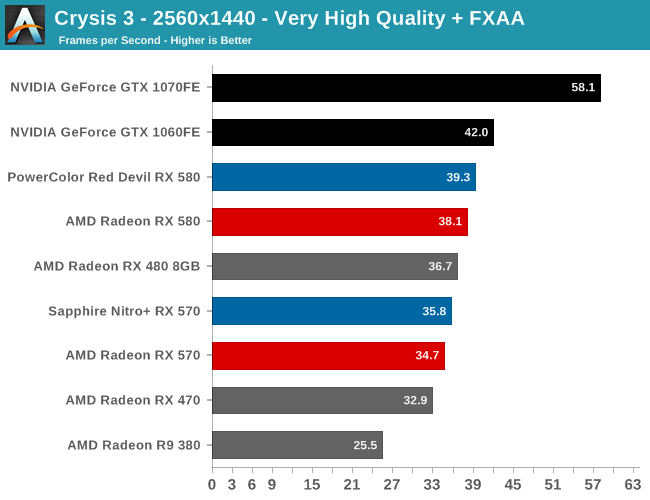The AMD Radeon RX 580 & RX 570 Review: A Second Path to Polaris
by Ryan Smith on April 18, 2017 9:00 AM EST- Posted in
- GPUs
- AMD
- Radeon
- Polaris
- Radeon RX 500
Crysis 3
Still one of our most punishing benchmarks 3 years later, Crysis 3 needs no introduction. Crytek’s DX11 masterpiece, Crysis 3’s Very High settings still punish even the best of video cards, never mind the rest. Along with its high performance requirements, Crysis 3 is a rather balanced game in terms of power consumption and vendor optimizations. As a result it can give us a good look at how our video cards stack up on average, and later on in this article how power consumption plays out.












129 Comments
View All Comments
milli - Tuesday, April 18, 2017 - link
I'm looking at the TPU review and the RX580 is winning by a big margin in RE7, Battlefield 1, COD, Deus Ex, Doom, F1 2016, Tomb Raider DX12 & Sniper Elite 4. All games from the past 6 months (more or less).Anandtech needs to urgently renew the tested games because these new games give a different view of these cards. In these games, even the Fury X often beats the GTX1070.
Ryan Smith - Tuesday, April 18, 2017 - link
The game selection gets updated roughly once a year. The current suite was rolled out for the launch of Pascal, and we'll be updating the benchmark suite for the launch of Vega a bit later this year.Phiro69 - Wednesday, April 19, 2017 - link
I appreciate your measured pace in updating your benchmarks. I frequently need to justify - even if to just myself - hardware upgrades and if you are constantly tweaking/changing your benchmark suite I can't do a fruit to fruit comparison between a product you reviewed a couple years ago vs a brand new review, let alone apple to apple comparison.So when you do refresh your benchmark suites, I know it's a huge time sink to include older hardware in the new suite, but it's very appreciated and it's the difference between the level of detail that Anandtech has vs the other sites with launch day benchmarks.
Azix - Tuesday, April 18, 2017 - link
should include clockspeed of the 1060 cardsRyan Smith - Tuesday, April 18, 2017 - link
Stock. So 1733MHz boost.Leyawiin - Tuesday, April 18, 2017 - link
The TechPowerUp review is a little more pointed where power consumption is concerned in that it removes the rest of the system to show the card only. Basically, the factory overclocked Sapphire RX 580 is using twice as power as the stock GTX 1060 FE in their basket of games for a 5% increase in performance (use a factory OC'd GTX 1060 and that gap is closed). That's kind of pitiful This is like the FX-9590 of the current midrange GPUs.Icehawk - Tuesday, April 18, 2017 - link
AMD seems to have a serious problem, both Ryzen and Polaris are pretty much maxed out from the factory clock & volt-wise whereas both Intel and NV have plenty of headroom.Lolimaster - Tuesday, April 18, 2017 - link
I don't really feel the need to OC the 1700. In fact I disable turbo and undervolted for sub 45°C load temps :DYou get so much cpu resources that OC is just an inefficient way to throw energy
BrokenCrayons - Wednesday, April 19, 2017 - link
Overclocking is usually a sub-optimal and inelegant solution to the need for more computer resources. Before the experience was curated and limited to price premium parts people could realize a benefit by wringing more from low budget components. Presently, with the bulk of overclockable components residing on the high end where there's already sufficient compute power available for tasks to perform adequately, overclocking is nothing but a corporate sales gimmick that appeals to people that want to needlessly tinker or to people who feel compelled to do so in order to be braggarts. For those attempting to overclock the few curated parts in lower price brackets, they're better served simply purchasing a marginally more expensive next higher tier component and running it within spec.As for underclocking and undervolting, I can see a possible advantage in greater longevity, higher reliability, and lower cost of operation. It just simply no longer makes sense to bother going through the fruitless trouble of reaching for more with little practical reward to reap from the effort and resources expended along the way.
Mugur - Thursday, April 20, 2017 - link
Yes, the problem is Global Foundry and their 14nm process...